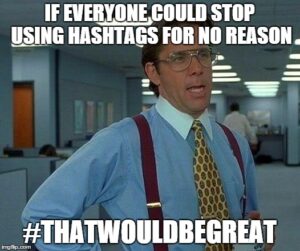
Influencer marketing is a misused and misunderstood buzzword. Some think it means to call up a Kardashian, pay them a bunch of money, and get them to share an Instagram post about your product or service.
While this is an example of influencer marketing, it is more of an outlier, especially for smaller businesses. Small businesses have much better options when it comes to influencer marketing.
First, what is influencer marketing? Here’s a good definition from the influencer marketing platform, Tapinfluence…
Influencer marketing is a type of marketing that focuses on using key leaders to drive your brand’s message to the larger market. Rather than marketing directly to a large group of consumers, you instead inspire/hire/pay influencers to get out the word for you.
This form of marketing is one of the most effective ways to reach and engage audiences not normally available to your business.
Street Teams
I play the drums and have a bunch of friends who have gone on tour. Do I regret never trying to be a touring musician? Maybe, but let’s stay on task here, ok?
Back in the day (which for me was the early 90s), there was no such thing as social media and the Internet was still in its infancy.
Touring bands would have to do everything by phone. They would call up venues or have a booking agent who did this for them. The shows were their only opportunity to engage with fans and future fans.
The smart bands would set up street teams in every city where they played. They would ask fans in each city if they would be interested in being on the band’s team. Sometimes, the team members would get free merch or tickets to future shows.
In exchange, they would be expected to hand out flyers and plaster the town with posters for upcoming shows. So, as they prepared a new tour, they would mail out flyers, stickers, and maybe some free tickets to their street teams.
Doing this got these bands exposure in advance of their shows and helped them build their fan base. More fans = more ticket, merch, and CD sales.
This was an early example of influencer marketing, in a sense. Street teams consisted of fans of the band who had an influence in their community when it came to what shows people should attend.
Influencer Marketing Today
Your brand is now looking for its modern-day street team. Social media influencers can be your boots on the ground, so to speak. They can get the word out about your business and help build your fanbase.
The most common misconception about this type of marketing is that you have to work with social media influencers who have millions of followers.
It could actually be a mistake to go after these heavy hitters. The problem is that they are so popular that they don’t have a real connection with their followers.
So, while you might get some good exposure, the chances of building a solid fanbase through these personalities are very small. You’re better off focusing on what influencer marketing expert, Neal Schaffer, calls micro and nano influencers, influencers having 10,000 and 1,000 followers, respectively.
Getting Started with Influencer Marketing
Any new marketing venture can be overwhelming. You’re faced with some familiar questions…
- Where can you find these micro and nano influencers?
- What social media platforms will work best?
- What tools and platforms will you need?
- Who will manage these efforts?
- Why would they work with you?
- What are your goals?
The last two questions are the most important, in my opinion. If you have solid answers to both, the rest will fall into place. Let’s take a deeper look at each…
Why Would an Influencer Work with You?
Going back to our street team example, the bands would approach fans for help. Imagine a musician going up to a completely random person and asking for that person to be on their street team.
This would be ludicrous for lesser-known bands. Similarly, the same is true for brands trying to court an influencer. Sure, a bunch of money could convince an influencer to work with you, but it will be hard to convince their followers that they truly value your brand.
Plus, they would have to disclose the fact that they are being paid for their promotion efforts (follow these federal guidelines to avoid any serious imperial entanglements).

Influencer marketing is most powerful when the influencer is truly a fan of the brand. Fandom doesn’t occur overnight. Fandom takes effort.
A solid foundation of positive brand recognition and reputation will make for more successful campaigns. You can build this over time using…
- Quality content that entertains and/or meets Google’s E-A-T standards
- A consistent and helpful social media presence in target channels
- A consistent brand presence
Basically, you are building brand authority so influencers will want to work with you. If you do not have sufficient brand authority, you better be super cool or cutting edge, otherwise, it will be difficult to convince these people to consider your offer.
Your Influencer Campaign Objectives
In addition to brand influence, you’ll need a clearly defined set of goals before approaching an influencer. Your campaign will be more successful if you and the influencer both clearly understand the campaign objectives.
For example, the campaign could be centered on building registrations for an event.
Or maybe the goal is to build awareness around a new product launch. Whatever your goal, make sure it is clear, attainable, trackable, and will justify the time and expense of working with an influencer.
Choose a goal that is focused and not some nebulous goal like “building awareness” or “growing followers.” These are legitimate goals in a sense but harder to quantify and track.
You’re better off starting out focusing on a goal with money attached to it, especially if you will need to show any sort of ROI to the higher-ups.
Develop an Influencer Profile
You have your own brand authority, and you’ve identified an appropriate goal. Great! Now it’s time to figure out what the perfect influencer looks like.
“Um, her name is Kayla and she has like, a gazillion followers on ShapChat!” Yeah, not that.
This exercise is similar to developing customer personas. You are creating an archetype of the perfect influencer. You might have influencers in mind already, which is great. Use them as the model in case they don’t want to work with you.
Detail the following in this profile…
- The ideal number of followers (remember your micro and nano crowds)
- Target platform where they hold influence
- Level of engagement and authenticity (are people into them, like, for reals?)
- Is a natural match for your brand
Remember, we’re talking about real people with organic reach and influence who would be open to working with your brand.
Finding Influencers
Now it’s time to find you an influencer. Again, if you had one in mind all along and they still make sense after going through the exercises above, reach out to them.
If you don’t have someone in mind, you’ll need to find someone. Buzzsumo is a great option for this. Of course, you can also just go looking.
Search for keywords or hashtags relating to your industry on the platform and see who is talking about it.

You can also divide and conquer. You may even find that someone on your team either knows of the perfect person or might even be that perfect person themselves.
Just don’t settle on one. Take the time and get a solid handful of candidates before moving on to the next step.
Landing Your Influencers
Now, set up calls with potential influencers. They will likely be flattered that you’ve reached out to them as an “influencer,” especially the nano-influencers. But, flattery will only get you so far.
Don’t lead with the carrot here. There are a few things they might be interested in…
- Great content they can share with their audience
- More exposure by aligning with your brand (if your brand has good authority)
- Money, gifts, freebies
- Fame and fortune
That last one is a joke, kind of. The point here is that they might be interested in working with you just to get access to more content they can share with their followers. If you lead with money, you’d miss this potential arrangement.
If they do want something of value from you, make sure you can afford to give it to them. Remember, you will likely be asked to show ROI if you want to continue with influencer marketing. Make sure you will come out net positive.
Measuring Success of Your Influencer Campaign
Never do any digital marketing unless you can track it. You’re wasting your money and time otherwise. Influencer marketing is no different.
Make sure you have the tools in place to track the success of your campaigns. And remember, more likes are not a success. You want to track whether or not you’re achieving those tangible goals.
The actual mechanics of tracking are pretty simple and can be done with free software like Google Analytics and your social media stats.
Some of the hooks you might want to use include…
- UTM codes in URLs
- Hashtags (there are tons of tools to help with this)
- Landing pages with tracking codes
- Marketing automation tracking codes
You’d be fine with any of those four, but don’t limit yourself. We recommend using marketing automation as the backbone of any digital marketing strategy. But that is another post altogether. Oh, wait, here it is.
Influencer marketing is not just a buzzword. It’s a powerful way to amplify your marketing efforts. And it isn’t just available to large companies, small businesses can get in on the action too.

I like memes, sue me!
Remember, build your brand authority, establish goals for your campaign, profile the perfect influencer, set up a mutually beneficial relationship, and track everything!
If you’re serious about influencer marketing, I highly recommend reading Neal Schaffer’s book, The Age of Influence.
Do you need help getting started with Influencer Marketing? We can help. Drop us a line or give us a call at 717.457.0522.